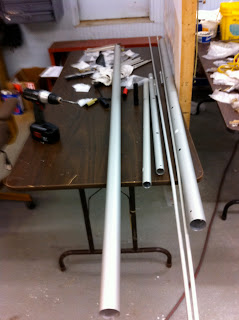I have been working the elevators. They are drilled out now and will need the usual disassembly/deburring/alodine and prime.
Here is the trim motor that sits inside the left elevator. I will drill the ribs to attach this later.
The plans did not originally have this reinforcing gusset. It has a late P/N and is only shown as an add on to the assembly. It is simple to install and stiffens up the elevator horn area. There is one on the top and bottom.
Here is the trim tab being drilled for the four hinges. The trim tab is only on the left hand elevator.
This is the trim tab horn.
Here the motor has been drilled in though you can't see that in this picture.
These are the two elevators sitting on top of each other.
I did double the number of rivets that will hold the right hand trailing edge onto the rear spar. My trim tab skins seemed a little puckered to me and this will lay that skin down tighter.
On to the rudder. Here are the main structural parts.
I should have it completed this week. Then it will be time for a weeks worth of deburring.























































